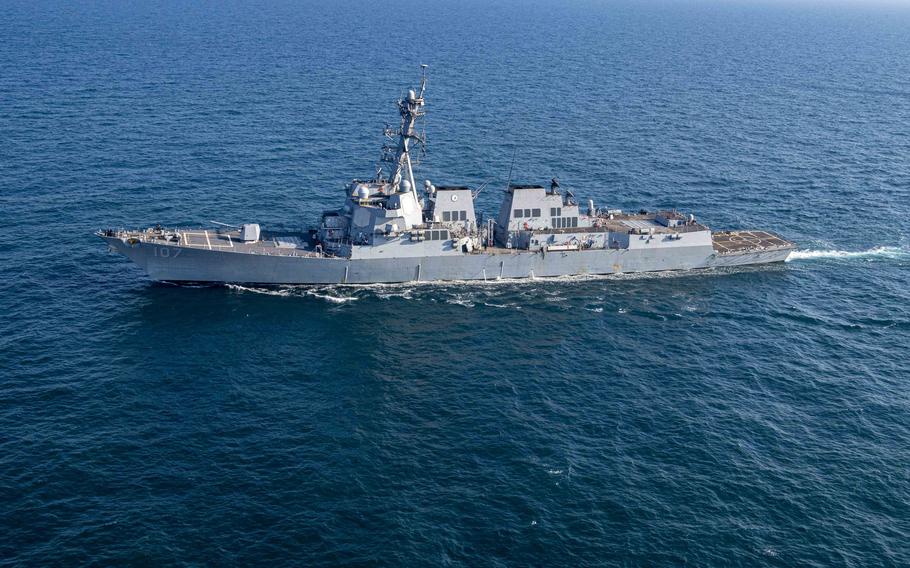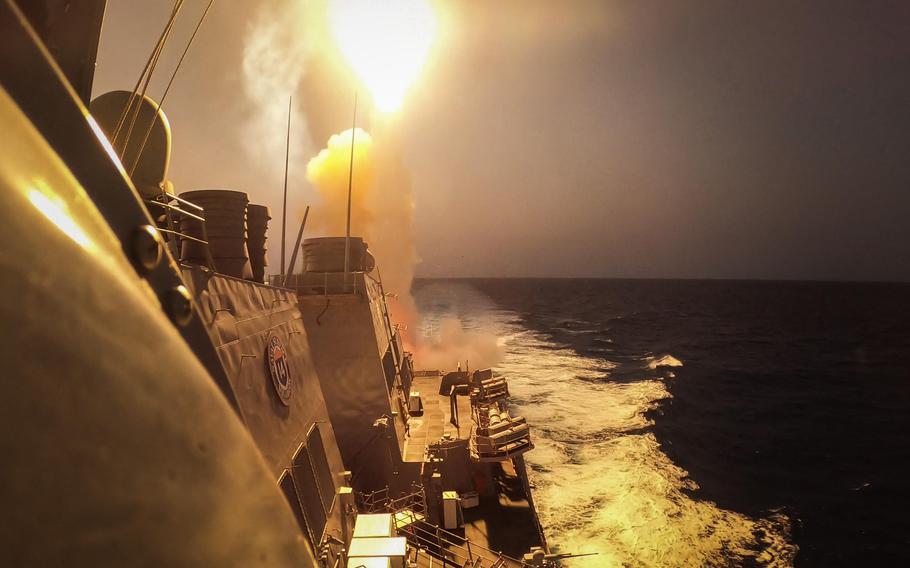
Petty Officer 2nd Class Brandon Frayde guides an E-2C Hawkeye to launch aboard the aircraft carrier USS Dwight D. Eisenhower in the Red Sea in November 2023. ( Janae Chambers/U.S. Navy)
A warning issued this week by the U.S. and 12 other countries likely puts the American military on course to strike an Iranian-backed group that is brazenly attacking commercial ships in the Red Sea, according to analysts.
Houthi militants have emerged from nearly 10 years of civil war in Yemen with a missile and drone arsenal that they’ve launched at ships transiting the Red Sea as a show of support for Hamas in its war with Israel.
The Houthis were warned against further attacks in a Wednesday statement from the White House that included the United Kingdom, Germany, Japan, Bahrain and eight other countries.
But the Houthis are unlikely to back down, meaning the U.S. will feel compelled to shift from protecting civilian sea traffic to offensive tactics if it wants to ensure the free flow of freight in an economically critical part of the world, experts said.
“The Houthis are starting to open up more, full throttle, in part because it doesn’t seem to be that there’s much perceived cost to the Houthis themselves,” said Jonathan Lord, senior fellow at the Center for a New American Security in Washington.
The group should not expect another warning if attacks continue, a senior Biden administration official told reporters Wednesday without detailing rules of possible engagement.
The U.S. defensive posture in the Red Sea has included a naval task force dubbed Prosperity Guardian, which thus far is composed primarily of America’s Navy and western allies. Aside from the task force, U.S. destroyers have shot down dozens of Houthi drones and missiles in recent months.

The destroyer USS Gravely sails in the Persian Gulf in early December 2023. The ship shot down two missiles fired from Houthi-controlled areas of Yemen on Dec. 31, 2023. (Janae Chambers/U.S. Navy)
The militants have attacked cargo ships 25 times, a total that includes firing missiles and drones, attempted hijackings and small boat skirmishes, according to Vice Adm. Brad Cooper, commander of the 5th Fleet.
The group says the attacks are meant to pressure Western countries into ending their support for Israel’s offensive into Gaza.
U.S. officials say that the ships under attack aren’t connected to Israel and that the disruptions affect a transit route for roughly 15% of global seaborne trade.
The Red Sea’s commercial importance has gained international attention for the Houthis, which gives them an incentive to keep going after cargo ships, according to analysts.
“Intercepting Houthi drones with expensive missiles is not going to stop the attacks,” said Sam Tangredi, the director of the U.S. Naval War College’s Institute for Future Warfare Studies.
Despite losing 10 people over the weekend after U.S. Navy helicopters sank three Houthi boats said to be firing on a civilian cargo ship, the militant group shows no signs of being deterred.
It will continue to prevent ships thought to be linked to Israel from navigating the Red Sea, a Houthi spokesman said Wednesday in a statement on X, formerly known as Twitter.
“The only way to make it clear that we will not tolerate their attacks on commercial ships and sailors of various nations is by destroying the means of attack,” said Tangredi, a retired Navy captain.

The destroyer USS Carney defeats a combination of Houthi missiles and unmanned aerial vehicles in the Red Sea in October 2023, according to the Navy. (Aaron Lau/U.S. Navy)
The U.S. has the capability to detect the launch positions of Houthi missiles and drones, as well as their storage locations, and it should attack these sites, he said.
Such strikes on Yemen’s soil would be the first, at least publicly, since 2016, when the U.S. launched Tomahawk missiles on three radar sites after two rounds of Houthi missile attacks on the destroyer USS Mason.
However, direct attacks on the Houthis risks galvanizing support for the group in Yemen, said Mohammed al-Basha, senior Middle East analyst for the Virginia-based Navanti Group.
The Houthis control Yemen’s capital of Sanaa and much of the northwest coast along the Red Sea. They’ve survived a nearly nine-year bombardment campaign by Saudi Arabia and allied countries, and the militants are confident in their ability to withstand U.S. barrages, al-Basha said.
“The Houthis’ string of victories has instilled in them a sense of euphoric hubris, perceiving divine intervention and an alignment with history on their side,” al-Basha said.
He added that they seem to believe that the U.S. and Western countries do not want a full-scale war, which would undo years of peace talks on ending Yemen’s civil war.
Houthi media outlets have heightened their already significant anti-American rhetoric, al-Basha said. Some Houthi figures are now threatening to target Saudi energy infrastructure if Yemen comes under attack, he added.